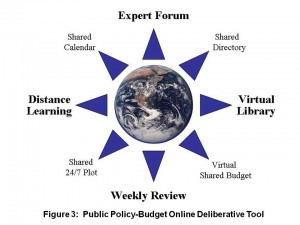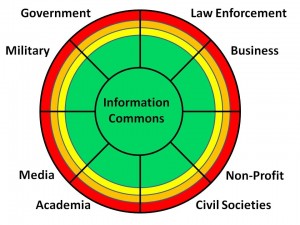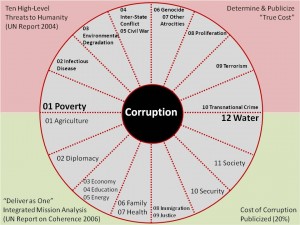
Journal: Brains Beat Algorithms….Again
04 Education, Advanced Cyber/IO, Analysis, Citizen-Centered, Civil Society, Collective Intelligence, info-graphics/data-visualization, InfoOps (IO), IO Sense-Making, Methods & Process, Politics of Science & Science of Politics, Tools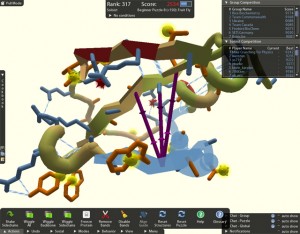
Today's issue of Nature contains a paper with a rather unusual author list. Read past the standard collection of academics, and the final author credited is… an online gaming community.
Scientists have turned to games for a variety of reasons, having studied virtual epidemics and tracked online communities and behavior, or simply used games to drum up excitement for the science. But this may be the first time that the gamers played an active role in producing the results, having solved problems in protein structure through the Foldit game. (Also related, TED talk on how gaming can make a better world).
Reference: Citation Analytics 201
About the Idea, Advanced Cyber/IO, Analysis, Analysis, Articles & Chapters, Augmented Reality, Balance, Budgets & Funding, Collaboration Zones, Collective Intelligence, Communities of Practice, History, ICT-IT, info-graphics/data-visualization, InfoOps (IO), Maps, Methods & Process, Multinational Plus, Policies, Policies-Harmonization, Policy, Political, Politics of Science & Science of Politics, Power Behind-the-Scenes/Special Interests, Processing, Real Time, Research resources, Secrecy & Politics of Secrecy, Strategy-Holistic Coherence, Threats, Tools, TribesPhi Beta Iota: Most serious analysts now understand Citation Analytics 101. It's time to move to Citation Analytics 202, and there is no better way to introduce the art of the possible than by pointing to Kevin W. Boyack, Katy Borner, and Richard Klavans (2007), “Mapping the Structure and Evolution of Chemistry Research (11th International Conference of Scientometrics and Infometrics, pp. 112-123.
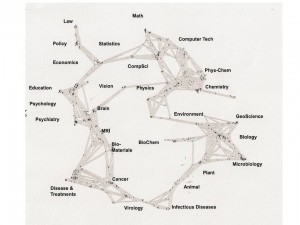

There are several take-aways from this article, which is more or less the “coming out” of the Klavens-inspired infometrics field now that he has won his law-suit and has unchallenged access to all Institute of Scientific Information (ISI) access [this was one of the sources we used to win the Burundi Exercise before the Aspin-Brown Commission in 1995].
Graphic: World Brain Eight Core Sharing Functions
Advanced Cyber/IO, Analysis, Balance, Capabilities-Force Structure, Citizen-Centered, Earth Orientation, Geospatial, Innovation, Multinational Plus, Policies-Harmonization, Political, Reform, Strategy-Holistic CoherenceGraphic: Information Commons & Eight Tribes
Advanced Cyber/IO, Analysis, Balance, Capabilities-Force Structure, Citizen-Centered, Innovation, Multinational Plus, Policies-Harmonization, Political, Reform, Strategy-Holistic Coherence, TribesInfographic: The Effects of Coal on Water in the US
03 Environmental Degradation, 05 Energy, 12 Water, info-graphics/data-visualization, True Cost, True Cost

August 16, 2010
The contest between coal-fired energy production and water demand is a mismatch. Mining and burning coal accounts for half of all water withdrawals in the United States, which is the same amount of water that pours over Niagara Falls in five months. Burning coal in power plants also is the source of more climate-changing carbon emissions than any other industrial sector. Here’s a look at the economically essential and ecologically damaging accord between coal and water.
NIGHTWATCH Extract: Colombian Constitution vs. US
Analysis, Corruption, Cultural Intelligence, Multinational Plus, Threats, TribesColombia: The Constitutional Court yesterday declared an agreement granting US military access to Colombian bases unconstitutional on procedural grounds. La Patilla reported the vote was 6-3 against the agreement, and Semana reported the court would soon give a press conference to explain the details. The constitutional court ruled the 2009 accord should be redrafted as an international treaty and sent to Colombia's Congress for approval.
The agreement would have allowed US forces to have access to seven Colombian bases that help support operations against drug trafficking and terrorism. This is the draft legislation that other Latin American leaders criticized lat year because it abetted a rise in US regional influence.
The deal agreed by former President Alvaro Uribe in October 2009 gave the US access to the bases for 10 years and would see a maximum of 800 US military personnel and 600 civilian defense contractors based in Colombia.
The court's chief justice Mauricio Gonzalez said the deal was “an arrangement which requires the State to take on new obligations as well as an extension of previous ones.” He said that as such, it should be “handled as an international treaty, that is, subject to congressional approval”. The court did not rule on the legitimacy of the agreement itself and the ruling does not mean the US has to leave the country altogether.
NIGHTWATCH Comment: President Juan Manuel Santos said the court ruling will have little impact on U.S. military help fighting rebels and will not affect the operations of U.S. troops and contractors working with Colombia's military, The Associated Press reported 18 August. The ruling is primarily procedural not substantive. Nonetheless, it will be an inconvenience.
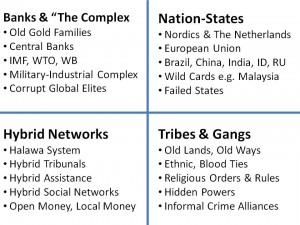 Phi Beta Iota: Here is a rough graphic showing the four spheres of influence that are fighting World War III. Nations are flexing their Constitutional muscles against US and external incursions, while at the same time, hybrid organizations and “hidden powers” are fighting in the shadows. Most Nation-States are no longer central because they have lost its legitimacy from a mix of internal corruption and external misadventure.
Phi Beta Iota: Here is a rough graphic showing the four spheres of influence that are fighting World War III. Nations are flexing their Constitutional muscles against US and external incursions, while at the same time, hybrid organizations and “hidden powers” are fighting in the shadows. Most Nation-States are no longer central because they have lost its legitimacy from a mix of internal corruption and external misadventure.
It is neither possible nor desireable to “fight” the established powers–Non-Zero Strategy requires a focus on the five billion and the creation of infinite wealth with social capitalism and Information Communication Technologies (ICT) as well as energy, food, and other innovations. Non-violent innovation is the only viable winning strategy.
Search: world map with 8 conflicts

